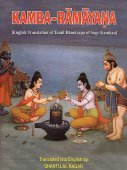Shravana, Śravaṇā, Sravana, Śravaṇa, Śrāvaṇa: 46 definitions
Introduction:
Shravana means something in Buddhism, Pali, Hinduism, Sanskrit, Jainism, Prakrit, the history of ancient India, Marathi, Hindi. If you want to know the exact meaning, history, etymology or English translation of this term then check out the descriptions on this page. Add your comment or reference to a book if you want to contribute to this summary article.
The Sanskrit terms Śravaṇā and Śravaṇa and Śrāvaṇa can be transliterated into English as Sravana or Shravana, using the IAST transliteration scheme (?).
Alternative spellings of this word include Sravan.
Images (photo gallery)
In Hinduism
Ayurveda (science of life)
Nighantu (Synonyms and Characteristics of Drugs and technical terms)
Source: WorldCat: Rāj nighaṇṭuŚravaṇā (श्रवणा) is another name for Śrāvaṇī, an unidentified medicinal plant, according to verse 5.17-18 of the 13th-century Raj Nighantu or Rājanighaṇṭu. The fifth chapter (parpaṭādi-varga) of this book enumerates sixty varieties of smaller plants (kṣudra-kṣupa). Together with the names Śravaṇā and Śrāvaṇī, there are a total of eight Sanskrit synonyms identified for this plant.
Toxicology (Study and Treatment of poison)
Source: Shodhganga: Kasyapa Samhita—Text on Visha ChikitsaŚravaṇa (श्रवण) (Nakṣatra) is considered negative for the recovery for a person to be bitten by snake, as taught in the Kāśyapa Saṃhitā: an ancient Sanskrit text from the Pāñcarātra tradition dealing with both Tantra and Viṣacikitsā—an important topic from Āyurveda which deals with the study of Toxicology (Agadatantra or Sarpavidyā).—The malignant asterisms and baneful lunar phases and astral combinations, with reference to snake-bite, are discussed in the tail-end of the fourth Adhyāya. [...] The Kāśyapasaṃhitā mentions the following details regarding the Nakṣatras:—The stars of a malignant nature that determine the virulence of the poison of the snake bite are [e.g., Śravaṇa] (Cf. verse IV.108)
Unclassified Ayurveda definitions
Source: archive.org: Vagbhata’s Ashtanga Hridaya Samhita (first 5 chapters)Sravaṇa (स्रवण) refers to “outflow” (e.g., of sperm), mentioned in verse 4.20-22 of the Aṣṭāṅgahṛdayasaṃhitā (Sūtrasthāna) by Vāgbhaṭa.—Accordingly, “[...] from (suppressed) sperm (result) its outflow [viz., sravaṇa], pubic pain, cutaneous swelling, fever, throbbing of the heart, retention of urine, racking in the limbs, swelling of the testicles, gravel, and impotence. Cock, arrack, rice, enema, inunction, bathing, milk prepared with bladder-cleansing (substances, and) lovely women one shall turn to in this case”.
Source: WikiPedia: AyurvedaSravana (blood-letting) is to be carried out in skin diseases, vidradhis, localised swelling, etc. (described in the Sushruta Samhita)

Āyurveda (आयुर्वेद, ayurveda) is a branch of Indian science dealing with medicine, herbalism, taxology, anatomy, surgery, alchemy and related topics. Traditional practice of Āyurveda in ancient India dates back to at least the first millenium BC. Literature is commonly written in Sanskrit using various poetic metres.
Jyotisha (astronomy and astrology)
Source: Wisdom Library: JyotiṣaŚravaṇa (श्रवण):—Name for a particular section of the ecliptic. It is also known as Śravaṇa-nakṣatra. Nakṣatra means “Lunar mansion” and corresponds to a specific region of the sky through which the moon passes each day. Śravaṇa means “hearing, reception” and is associated with the deity known as Viṣṇu (God of existence). The presiding Lord of this lunar house is Chandra (Moon).
Indian zodiac: |10°| – |23°20' Makara|
Makara (मकर, “sea-monster”) corresponds with Capricorn.
Western zodiac: |6°| – |19°20' Aquarius|
Aquarius corresponds with Kumbha (कुम्भ, “pitcher”).
1) Śravaṇa (श्रवण) refers to the “ears”, according to the Bṛhatsaṃhitā (chapter 2), an encyclopedic Sanskrit work written by Varāhamihira mainly focusing on the science of ancient Indian astronomy astronomy (Jyotiṣa).—Accordingly, “We shall now proceed to give a brief description of (the qualifications of) a jyotiṣaka. He must be of noble birth and of agreeable appearance; meek, truthful and without jealousy; of proportional limbs; of joints well built and of good growth; have no physical defects; be of fine hands, feet, nails, eyes, chin, teeth, ears [i.e., śravaṇa], forehead, eye-brows and head; of fine physique and of high, sonorous voice”.
2) Śrāvaṇa (श्रावण) refers to the lunar month corresponding to July-August (when the full moon is in the constellation of Śrāvaṇa), according to the Bṛhatsaṃhitā (chapter 5).—Accordingly, “If there should be both lunar and solar eclipses in one month, princes will suffer both from dissensions among their own army and from wars. [...] If the eclipses should fall in the lunar month of Śrāvaṇa, the people of Kāśmīra, of Pulinda and of Cīna (China), the Yavanas, the Kurus, the Gāndhāras and the people of Madhyadeśa (Central Provinces), the horses of Kāmboja and the crops of Śarat will perish; the rest of mankind will enjoy prosperity and will be happy”.

Jyotisha (ज्योतिष, jyotiṣa or jyotish) refers to ‘astronomy’ or “Vedic astrology” and represents the fifth of the six Vedangas (additional sciences to be studied along with the Vedas). Jyotisha concerns itself with the study and prediction of the movements of celestial bodies, in order to calculate the auspicious time for rituals and ceremonies.
Natyashastra (theatrics and dramaturgy)
Source: Wisdom Library: Nāṭya-śāstraŚravaṇā (श्रवणा) is a Sanskrit word referring to the asterism Aquilae. According to the Nāṭyaśāstra 2.43-45, the ceremony of “raising the pillars” within the playhouse (nāṭyamaṇḍapa) should be performed during an auspicious tithi and karaṇa under either the asterism Rohiṇī or Śravaṇā. Accordingly, “the master [of dramatic art], after he has fasted for three [days and] nights, is to raise the pillars in an auspicious moment at dawn”. These two asterisms are considered auspicious for this purpose.

Natyashastra (नाट्यशास्त्र, nāṭyaśāstra) refers to both the ancient Indian tradition (shastra) of performing arts, (natya—theatrics, drama, dance, music), as well as the name of a Sanskrit work dealing with these subjects. It also teaches the rules for composing Dramatic plays (nataka), construction and performance of Theater, and Poetic works (kavya).
Purana and Itihasa (epic history)
Source: Wisdom Library: Varāha-purāṇaŚravaṇa (श्रवण).—Name of a settlement (janapada) situated near the seven great mountains on the western side of mount Naiṣadha, according to the Varāhapurāṇa chapter 83. These settlements consume the water flowing from these seven great mountains (Viśākha, Kambala, Jayanta, Kṛṣṇa, Harita, Aśoka and Vardhamāna). Niṣadha (Naiṣadha) is one of the seven mountains located in Jambūdvīpa, ruled over by Āgnīdhra, a grandson of Svāyambhuva Manu, who was created by Brahmā, who was in turn created by Nārāyaṇa, the unknowable all-pervasive primordial being.
Source: archive.org: Puranic Encyclopedia1) Śravaṇa (श्रवण).—A son of Murāsura. Murāsura had seven sons. They were: Tāmra, Antarīkṣa, Śravaṇa, Vasu, Vibhāvasu, Nabhasvān and Aruṇa. They were all killed by Śrī Kṛṣṇa. (Bhāgavata, Skandha 10).
2) Śravaṇa (श्रवण).—One of the twentyseven stars (nakṣatras). Those who perform Śrāddha on the day of this star will attain heaven. (Mahābhārata Anuśāsana Parva, Chapter 39, Verse 11).
3) Śrāvaṇa (श्रावण).—See 3rd Para under Daśaratha.
Source: archive.org: Nilamata Purana: a cultural and literary studyŚravaṇa (श्रवण) or Śravaṇa Dvādaśī is the name of a festival that once existed in ancient Kashmir (Kaśmīra) as mentioned in the Nīlamatapurāṇa.—Śravaṇa Dvādaśī proceeds as follows: Fasting and the worship of Viṣṇu are prescribed on the dark 12th of Phālguṇa conjoined with Śravaṇa constellation.
Source: archive.org: Shiva Purana - English Translation1) Śravaṇa (श्रवण, “listening”) refers to one of the three rites mentioned in the Śivapurāṇa 1.3. Accordingly, “[...] Rites mentioned in the Vedas should be performed with the fruits thereof dedicated to Him. Thence, through Sālokya he attains the feet of the great Lord. [...] Regarding visible things people see with their eyes and begin their activity. Concerning the invisible everywhere, they know through the ears and activise themselves. Hence Śravaṇa (listening) is the first rite. The intelligent scholar must listen to the oral explanation of the preceptor and then practise the other rites.—Kīrtana (glorifying) and Manana ( deliberation)”.d
2) Śravaṇa (श्रवण, “listening”) represents one of the nine-fold (navadhā) devotion (bhakti), as explained in the Śivapurāṇa 2.2.23.—Śravaṇa (‘listening’) detailed explanation: “by listening is meant the imbibing of my stories that bestow worldly pleasures and salvation, with great devotion, in steady posture”.
3) Śravaṇā (श्रवणा) refers to a “female ascetic”, according to the Śivapurāṇa 2.3.54 (“Description of the duties of the chaste wife”).—Accordingly, as a Brahmin lady said to Pārvatī: “[...] If a chaste lady wishes for the longevity of her husband she shall not forsake turmeric, vermilion, saffron, collyrium, a blouse, the betel, the necklace, ornaments, brushing and plaiting the hair bangles and earrings. A chaste woman shall never associate intimately with a washerwoman, a harlot, a female ascetic (śravaṇā) or a fallen woman. [...]”.
4) Śravaṇa (श्रवण) refers to the “ears”, according to the Śivapurāṇa 2.5.6 (“Prayer to Śiva”).—Accordingly, as the Gods eulogized Śiva: “Obeisance to you, the soul of all, obeisance to Śiva the remover of distress, [...] I bow to you everywhere, you who have hands, legs, eyes, heads, mouths, ears (śravaṇa) and noses everywhere. I bow to you everywhere, you who are omniscient who pervade everything, you who are unveiled as the lord of al, you who are omniformed and odd-eyed. [...]”.
Source: Cologne Digital Sanskrit Dictionaries: The Purana Index1a) Śravaṇa (श्रवण).—The constellation;1 importance of Śrāddha that day.2
- 1) Bhāgavata-purāṇa IV. 12. 48; Vāyu-purāṇa 50. 127; 53. 116; 66. 51; 82. 11.
- 2) Brahmāṇḍa-purāṇa III. 18. 11.
1b) A son of Mura.*
- * Bhāgavata-purāṇa X. 59. 12.
1c) A son of Aśvinī and Akrūra.*
- * Matsya-purāṇa 45. 33.
1d) A Janapada of the Ketumālā.*
- * Vāyu-purāṇa 44. 15.
2) Śravaṇā (श्रवणा).—A daughter of Citraka.*
- * Brahmāṇḍa-purāṇa III. 71. 115; Vāyu-purāṇa 96. 114.
3a) Śrāvaṇa (श्रावण).—The name of the month and Nakṣatra; god for gift of the vāyu purāṇa;1 Kṛṣṇāṣṭamī of this month good for śrāddha.2
3b) A son of Gautama, an avatār of the 14th dvāpara.*
- * Vāyu-purāṇa 23, 164.

The Purana (पुराण, purāṇas) refers to Sanskrit literature preserving ancient India’s vast cultural history, including historical legends, religious ceremonies, various arts and sciences. The eighteen mahapuranas total over 400,000 shlokas (metrical couplets) and date to at least several centuries BCE.
Vastushastra (architecture)
Source: Wisdom Library: Vāstu-śāstraŚravaṇa (श्रवण) refers to the twenty-third of twenty-seven constellations (ṛkṣa), according to the Mānasāra. Ṛkṣa is the third of the āyādiṣaḍvarga, or “six principles” that constitute the “horoscope” of an architectural or iconographic object. Their application is intended to “verify” the measurements of the architectural and iconographic object against the dictates of astrology that lay out the conditions of auspiciousness.
The particular nakṣatra, also known as ṛkṣa (e.g., śravaṇa) of all architectural and iconographic objects (settlement, building, image) must be calculated and ascertained. This process is based on the principle of the remainder. An arithmetical formula to be used in each case is stipulated, which engages one of the basic dimensions of the object (breadth, length, or perimeter/circumference). In the context of village planning and measurement, the text sates that among the stars (ṛkṣa), the ones that are pūrṇa (odd), are auspicious and the ones that are karṇa (even), inauspicious.
Source: Brill: Śaivism and the Tantric Traditions (architecture)Śravaṇa (श्रवण) (or Ṛgi) refers to one of the deities to be installed in the ground plan for the construction of houses, according to the Bṛhatkālottara, chapter 112 (the vāstuyāga-paṭala).—The plan for the construction is always in the form of a square. That square is divided into a grid of cells (padas). [...] Once these padas have been laid out, deities [e.g., Śravaṇa] are installed in them. In the most common pattern 45 deities are installed.
Śravaṇa as a doorway deity is associated with the Nakṣatra called Śravaṇa and the consequence is dainya. [...] The Mayasaṃgraha (verse 5.156-187) describes a design for a 9-by-9-part pura, a residential complex for a community and its lead figure. [...] This record lists a place for the treasury at Soma and Ṛgi (somadvaye).

Vastushastra (वास्तुशास्त्र, vāstuśāstra) refers to the ancient Indian science (shastra) of architecture (vastu), dealing with topics such architecture, sculpture, town-building, fort building and various other constructions. Vastu also deals with the philosophy of the architectural relation with the cosmic universe.
Vyakarana (Sanskrit grammar)
Source: Wikisource: A dictionary of Sanskrit grammarŚravaṇa (श्रवण).—Hearing of a phonetic element or a word in the actual speech; audition; cf. तस्य चोदात्तस्वरितपरत्वे श्रवणं स्पष्टम् (tasya codāttasvaritaparatve śravaṇaṃ spaṣṭam) S. K. on P.I.2.32. In many technical grammatical terms, affixes and substitutes, there is sometimes a portion of them which is not a vital part of the word, but it is for the sake of causing certain prescribed grammatical operations. The letters or syllables which form such a portion are called इत् (it) and they are only for the sake of grammatical operations (कार्यार्थ (kāryārtha)), as contrasted with the other ones which are actually heard (श्रुत्यर्थ (śrutyartha) or श्रवणार्थ (śravaṇārtha)).

Vyakarana (व्याकरण, vyākaraṇa) refers to Sanskrit grammar and represents one of the six additional sciences (vedanga) to be studied along with the Vedas. Vyakarana concerns itself with the rules of Sanskrit grammar and linguistic analysis in order to establish the correct context of words and sentences.
Dharmashastra (religious law)
Source: Knowledge Traditions & Practices of India: Education: Systems & PracticesŚravaṇa (श्रवण) refers to the first of three stages of learning according to the Bṛhadāraṇyaka Upaniṣad, forming part of the ancient Indian education system, which aimed at both the inner and the outer dimension of a person. In the first stage, śravaṇa, students listened intently to the teacher.

Dharmashastra (धर्मशास्त्र, dharmaśāstra) contains the instructions (shastra) regarding religious conduct of livelihood (dharma), ceremonies, jurisprudence (study of law) and more. It is categorized as smriti, an important and authoritative selection of books dealing with the Hindu lifestyle.
Vaishnavism (Vaishava dharma)
Source: Pure Bhakti: Arcana-dipika - 3rd EditionŚrāvaṇa (श्रावण), corresponding to “July-August”, refers to one of the months (māsa) in the Vedic calendar.—There are twelve months in a Vedic lunar calendar, and approximately every three years, there is a thirteenth month. Each month has a predominating deity and approximately corresponds with the solar christian months. [...] In accordance with the month of the year, one would utter the Vedic month, for example, śrāvaṇa-māsi.
The presiding deity of Śrāvaṇa is Śrīdhara.
Source: Pure Bhakti: Brhad BhagavatamrtamŚravaṇa (श्रवण) refers to:—Hearing the transcendental descriptions of Bhagavān’s names, forms, qualities, pastimes, and associates from the mouths of advanced bhaktas; one of the three most important limbs of bhakti. (cf. Glossary page from Śrī Bṛhad-bhāgavatāmṛta).

Vaishnava (वैष्णव, vaiṣṇava) or vaishnavism (vaiṣṇavism) represents a tradition of Hinduism worshipping Vishnu as the supreme Lord. Similar to the Shaktism and Shaivism traditions, Vaishnavism also developed as an individual movement, famous for its exposition of the dashavatara (‘ten avatars of Vishnu’).
Shaktism (Shakta philosophy)
Source: Google Books: Manthanabhairavatantram1) Sravaṇa (स्रवण) refers to “falling” [pouring down?] (of nectar), according to the commentary (vyākyā) on the Ṣaṭsāhasrasaṃhitā, an expansion of the Kubjikāmatatantra: the earliest popular and most authoritative Tantra of the Kubjikā cult.—Accordingly, “(The goddess) abides in many states of being up to the location of the void of the End of the Twelve, within which she causes nectar to fall [i.e., amṛta-sravaṇa] if she is there in the form of the Self. Thus she ‘resides in the midst of the ocean of nectar’. What is nectar? It is the juice of the Void. Thus she is Mālinī of the Void. She abides (there) having pervaded the Void. What does she do there? How does she abide? ‘Established in movement, she is the one who impels (its) motion’. She abides in the movement and she transports it”.
2) Sravaṇa (स्रवण) refers to the “flow (of blood)” (during menses), according to the Ṭīkā (commentary) on the Manthānabhairavatantra, a vast sprawling work that belongs to a corpus of Tantric texts concerned with the worship of the goddess Kubjikā..—Accordingly, “[...] Or else, it is like the flower (of menses). Blood flows (rakta-sravaṇa) in the female genitals every month. How can living beings who are forms of Nature be born from just the semen that comes from the father without that? In the same way, one should not reveal this Sequence of Twenty-eight to one who is devoid of a line of teachers, initiation, the hereafter, lineage and transmission of the teachers”.

Shakta (शाक्त, śākta) or Shaktism (śāktism) represents a tradition of Hinduism where the Goddess (Devi) is revered and worshipped. Shakta literature includes a range of scriptures, including various Agamas and Tantras, although its roots may be traced back to the Vedas.
Kavya (poetry)
Source: Brill: Śaivism and the Tantric Traditions (kavya)Śravaṇa (श्रवण) refers to the “ears”, according to Bāṇa’s Kādambarī (p. 226).—There are apparently several Tantric rites that Bāṇa pejoratively associates with the priest: [...] “his collection of practices for mastering mantras for invisibility had grown”; “he was acquainted with a hundred tales about the marvels of the Śrīparvata mountain”; “his ear-cavities (śravaṇa-puṭa) were punched by those possessed by Piśāca-demons, who had run to him when struck by white mustard seed he had empowered with mantras more than once”.

Kavya (काव्य, kavya) refers to Sanskrit poetry, a popular ancient Indian tradition of literature. There have been many Sanskrit poets over the ages, hailing from ancient India and beyond. This topic includes mahakavya, or ‘epic poetry’ and natya, or ‘dramatic poetry’.
Yoga (school of philosophy)
Source: Brill: Śaivism and the Tantric Traditions (yoga)Śravaṇa (श्रवण) refers to “listening (to the teachings)”, according to Śivānandasarasvatī’s Yogacintāmaṇi, a 17th-century text on Haṭhayoga by consisting of 3423 verses.—Accordingly, “Meditation along with the practices [ancillary to it] have been explained briefly by me according to scripture and my understanding. Listening to (śravaṇa) and contemplating [the teachings] which are seen in detail and at length only in the Upaniṣads, have not been discussed for fear of prolixity. [...]”.
Source: ORA: Amanaska (king of all yogas): A Critical Edition and Annotated Translation by Jason Birch1) Śravaṇa (श्रवण) refers to “(the faculty of) hearing”, according to the Amanaska Yoga treatise dealing with meditation, absorption, yogic powers and liberation.—Accordingly, as Īśvara says to Vāmadeva: “[...] [Now], I shall define the nature of that highest, mind-free absorption which arises for those devoted to constant practice. [...] By means of an absorption for five [days and] nights, the faculty of hearing (śravaṇa-vijñāna) from afar, which causes great wonder, certainly arises for the [Yogin]. [...]”.
2) Śravaṇa (श्रवण) refers to the “study” (of philosophy), according to the Yogayājñavalkya 2.8-10ab.—Accordingly, while discussing the study of the Upaniṣads and the Purāṇas: “[In the case of Brahmins,] the wise say that the study (śravaṇa) of philosophy, [which is the sixth Niyama in this yoga system,] is the study (śravaṇa) of the Upaniṣads. Like Brahmins, they prescribe the study (śravaṇa) of [the same] philosophy for Kṣatriyas. And †...† for good Vaiśyas, possessed of virtuous conduct, as well as [those] Śūdras, women and ascetics who maintain their religious duties, the wise say that the study (śravaṇa) of philosophy is the study (śravaṇa) of the Purāṇas”.

Yoga is originally considered a branch of Hindu philosophy (astika), but both ancient and modern Yoga combine the physical, mental and spiritual. Yoga teaches various physical techniques also known as āsanas (postures), used for various purposes (eg., meditation, contemplation, relaxation).
Shaivism (Shaiva philosophy)
Source: SOAS University of London: Protective Rites in the Netra TantraŚravaṇa (श्रवण) refers to “one who learns”, according to the Svacchanda-tantra.—Accordingly, [verse 7.210-211, while describing the meditation on the kālahaṃsa]—“Either by reciting or meditating on the kālahaṃsa, O Goddess, [the practitioner] becomes Śiva [who] has the form of kāla and acts freely (or as Svacchanda) like kāla. Death has been destroyed, [the Yogin] has abandoned old age, is free from all danger [caused by] disease, [he] knows, learns (śravaṇa), and day-dreams. [He] gains the all supreme siddhis, [which] arise constantly as a result of conquering kāla”.

Shaiva (शैव, śaiva) or Shaivism (śaivism) represents a tradition of Hinduism worshiping Shiva as the supreme being. Closely related to Shaktism, Shaiva literature includes a range of scriptures, including Tantras, while the root of this tradition may be traced back to the ancient Vedas.
In Buddhism
Tibetan Buddhism (Vajrayana or tantric Buddhism)
Source: Wisdom Library: Tibetan Buddhism1a) Śravaṇā (श्रवणा) is the name of Vidyārājñī (i.e., “wisdom queen”) mentioned as attending the teachings in the 6th century Mañjuśrīmūlakalpa: one of the largest Kriyā Tantras devoted to Mañjuśrī (the Bodhisattva of wisdom) representing an encyclopedia of knowledge primarily concerned with ritualistic elements in Buddhism. The teachings in this text originate from Mañjuśrī and were taught to and by Buddha Śākyamuni in the presence of a large audience (including Śravaṇā).
1b) Śravaṇā (श्रवणा) also refers to one of the various Nakṣatras mentioned as attending the teachings in the 6th century Mañjuśrīmūlakalpa.
2) Śravaṇa (श्रवण) is the name of a Śrāvaka mentioned as attending the teachings in the 6th century Mañjuśrīmūlakalpa.
Source: archive.org: The Indian Buddhist Iconography1) Śravaṇā (श्रवणा) refers to the twenty-second of the 28 nakṣatras (“constellations”) of the zodiac, as commonly depicted in Buddhist Iconography, and mentioned in the 11th-century Niṣpannayogāvalī of Mahāpaṇḍita Abhayākara.—The nakṣatras are described collectively in the dharmadhātuvāgīśvara-maṇḍala of the Niṣpannayogāvalī. In this maṇḍala the nakṣatras are given one face and two arms, which are clasped against the chest in the añjalimudrā:—“the deities [viz., Śravaṇā] are decked in bejewelled jackets and they all show the añjali-mudrā”.—In colour, however, they differ. [viz., Śravaṇā is given the colour white].
2) Śrāvaṇa (श्रावण) (presided over by Samudra) also refers to the tenth of twelve months, according to the Niṣpannayogāvalī.—Accordingly, there are altogether twelve months [viz., Śrāvaṇa] having twelve deities as given in the kālacakra-maṇḍala.—“here they are all accompanied with their Śaktis, mostly four-armed and have their distinctive vehicles”.
Source: academia.edu: A Critical Study of the Vajraḍākamahātantrarāja (II)Śravaṇa (श्रवण) is the name of a Vākchomā (‘verbal secrect sign’) which has its meaning defined as ‘karṇa’ according to chapter 8 of the 9th-century Vajraḍākamahātantrarāja, a scripture belonging to the Buddhist Cakrasaṃvara (or Saṃvara) scriptural cycle. These Vākchomās (viz., śravaṇa) are meant for verbal communication and can be regarded as popular signs, since they can be found in the three biggest works of the Cakrasaṃvara literature.

Tibetan Buddhism includes schools such as Nyingma, Kadampa, Kagyu and Gelug. Their primary canon of literature is divided in two broad categories: The Kangyur, which consists of Buddha’s words, and the Tengyur, which includes commentaries from various sources. Esotericism and tantra techniques (vajrayāna) are collected indepently.
Mahayana (major branch of Buddhism)
Source: archive.org: Bulletin of the French School of the Far East (volume 5)Śravaṇā (श्रवणा) is the name of a Nakṣatra mentioned in chapter 18 of the Candragarbha: the 55th section of the Mahāsaṃnipāta-sūtra, a large compilation of Sūtras (texts) in Mahāyāna Buddhism partly available in Sanskrit, Tibetan and Chinese.—Chapter 18 deals with geographical astrology and, in conversation with Brahmarāja and others, Buddha explains how he entrusts the Nakṣatras [e.g., Śravaṇā] with a group of kingdoms for the sake of protection and prosperity.
The Śravaṇānakṣatra comprises the following realms:
- A-leou-na (Aruṇa),
- Kieou-sseu-so[p'o]-lo-chö-li (Kusisarajari or Kusivarajari?),
- Tchan-po-teou-chai (Campātuśi?),
- Kieou-tseu (Koutcha),
- Mo-lan-feou-cha (Malaṃpuṣa?),
- Chö-kia (Śaka),
- Wou-t'o-lo-to (Udarata?),
- Chai-t'i (Ṣadhi, Siti, Śiti?),
- K'iu-che (Gośi?),
- P'o[So]-lo-mi (Varami or Sarami?).
Śravaṇa (श्रवण) refers to “hearing (the dharma)”, according to the Gaganagañjaparipṛcchā: the eighth chapter of the Mahāsaṃnipāta (a collection of Mahāyāna Buddhist Sūtras).—Accordingly: “Then, the Bodhisattva, Dharmarāja by name, addressed himself to the Bodhisattva Gaganagañja: ‘Son of good family, let me listen to the treasury of hearing the dharma (dharma-śravaṇa-gañja) from open space’. Gaganagañja said: ‘If you conceive the concept of this open space as your teacher, with respect and reverence, son of good family, then you will listen to the treasury of hearing the dharma (dharma-śravaṇa)’. [...]”.

Mahayana (महायान, mahāyāna) is a major branch of Buddhism focusing on the path of a Bodhisattva (spiritual aspirants/ enlightened beings). Extant literature is vast and primarely composed in the Sanskrit language. There are many sūtras of which some of the earliest are the various Prajñāpāramitā sūtras.
In Jainism
General definition (in Jainism)
Source: archive.org: TrisastisalakapurusacaritraŚravaṇa (श्रवण) refers to “hearing” and represents one of the eight dhīguṇas (eight qualities), named in the Yogaśāstra, comentary p. 53a (Bhavnagar ed.).
Source: archive.org: The Jaina IconographyŚravaṇa (श्रवण) refers to one of the various attendants of Kubera (king of the Yakṣas).—Kubera was the treasurer of Śiva and lord of the Alakā is several times referred to in early Hindu literature. His attendants were many and several of them are mentioned in a canonical text of the Jainas thus, [viz., Śravaṇa].
Source: The University of Sydney: A study of the Twelve ReflectionsŚravaṇa (श्रवण) refers to “learning”, according to the 11th century Jñānārṇava, a treatise on Jain Yoga in roughly 2200 Sanskrit verses composed by Śubhacandra.—Accordingly, “Here ends [the commentary on] the second chapter on the twelve reflections, by Paṇḍita Nayavilāsa who caused [it] to be done (kārāpitena) for the sake of his own learning (sva-śravaṇa-artha) with the inspiration of Paṇḍita Jinadāsa on account of [the request of] Sāha Ṛṣidāsa the son of Sāha Ṭoḍara the son of Sāha Pāsā, in the principal text [constituting] the ‘Ocean of Knowledge’, which has the aim of illuminating yoga, composed by Ācārya Śubhacandra”.

Jainism is an Indian religion of Dharma whose doctrine revolves around harmlessness (ahimsa) towards every living being. The two major branches (Digambara and Svetambara) of Jainism stimulate self-control (or, shramana, ‘self-reliance’) and spiritual development through a path of peace for the soul to progess to the ultimate goal.
India history and geography
Source: Cologne Digital Sanskrit Dictionaries: Indian Epigraphical GlossaryŚrāvaṇa.—(SITI), also called śrāvaṇa-patra (q. v.), sale deed; a document; cf. śālāvaṇam (SITI), a sale deed (āvaṇa-śālāvaṇam). Note: śrāvaṇa is defined in the “Indian epigraphical glossary” as it can be found on ancient inscriptions commonly written in Sanskrit, Prakrit or Dravidian languages.

The history of India traces the identification of countries, villages, towns and other regions of India, as well as mythology, zoology, royal dynasties, rulers, tribes, local festivities and traditions and regional languages. Ancient India enjoyed religious freedom and encourages the path of Dharma, a concept common to Buddhism, Hinduism, and Jainism.
Languages of India and abroad
Marathi-English dictionary
Source: DDSA: The Molesworth Marathi and English Dictionaryśravaṇa (श्रवण).—n S The hypotenuse of a right-angled triangle.
--- OR ---
śravaṇa (श्रवण).—n (S) Hearing. 2 n m The sense or the organ of hearing. 3 n The twenty-second nakshatra or lunar asterism. śravaṇamanananididhyāsa Hearkening or hearing, mentally revolving, and intently contemplating or considering. These three are the appointed exercises of all derived intelligencies towards the apprehension of Knowledge or Truth, i. e. Spirit or the Deity. Ex. sadā āvaḍē haribhajana || śravaṇamanananidi- dhyāsana || tēthēṃ vikalpa pravēśē nā ||.
--- OR ---
śrāvaṇa (श्रावण).—m (S) The fifth month of the Hindu year,--July-August.
--- OR ---
śrāvaṇā (श्रावणा).—a śrāvaṇī a Relating to the month Shrawan̤.
Source: DDSA: The Aryabhusan school dictionary, Marathi-Englishśravaṇa (श्रवण).—n Hearing. n m The sense of hear- ing. n The 22nd nakṣatra.
--- OR ---
śrāvaṇa (श्रावण).—m The 5th month of the Hindu year.
--- OR ---
sravaṇa (स्रवण).—n Dripping. Urine. Sweat.
Marathi is an Indo-European language having over 70 million native speakers people in (predominantly) Maharashtra India. Marathi, like many other Indo-Aryan languages, evolved from early forms of Prakrit, which itself is a subset of Sanskrit, one of the most ancient languages of the world.
Sanskrit dictionary
Source: DDSA: The practical Sanskrit-English dictionaryŚravaṇa (श्रवण).—[śṛṇotyanena śru-karaṇe lyuṭ]
1) The ear; ध्वनति मधुपसमूहे श्रवणमपिदधाति (dhvanati madhupasamūhe śravaṇamapidadhāti) Gītagovinda 5; श्रवणाञ्जलिपुटपेयं विरचितवान् भारताख्यममृतं यः (śravaṇāñjalipuṭapeyaṃ viracitavān bhāratākhyamamṛtaṃ yaḥ) Ve.1.4.
2) The hypotenuse of a triangle.
-ṇaḥ, -ṇā 1 Name of a lunar mansion containing three stars.
-ṇam 1 The act of hearing; श्रवणसुभगम् (śravaṇasubhagam) Meghadūta 11.
2) Study.
3) Fame, glory.
4) That which is heard or revealed, the Veda; इति श्रवणात् (iti śravaṇāt) 'because of such a Vedic text'.
5) Wealth.
6) Flowing, oozing.
7) (In phil.) The determining by means of the six signs the true doctrine of the Vedānta.
Derivable forms: śravaṇaḥ (श्रवणः), śravaṇam (श्रवणम्).
--- OR ---
Śrāvaṇa (श्रावण).—a. (-ṇī f.) [श्रवण-अण् (śravaṇa-aṇ)]
1) Relating to the ear.
2) Born under the asterism Śravaṇa.
3) Enjoined in the Veda; विधिना श्रावणेनैव कुर्यात् कर्माण्यतन्द्रितः (vidhinā śrāvaṇenaiva kuryāt karmāṇyatandritaḥ) Mahābhārata (Bombay) 12. 21.16.
-ṇaḥ 1 Name of a lunar month (corresponding to July-August).
2) A heretic.
3) An impostor.
4) Name of a Vaiśya ascetic unwittingly shot dead by king Daśaratha who was in consequence cursed by his old parents that he would die of broken-heart separated from his sons.
-ṇam 1 Causing to be heard.
2) Knowledge derived from hearing.
--- OR ---
Sravaṇa (स्रवण).—[sru-lyuṭ]
1) Flowing, trickling, oozing.
2) Sweat.
3) Urine.
4) Premature abortion.
Derivable forms: sravaṇam (स्रवणम्).
Source: Cologne Digital Sanskrit Dictionaries: Edgerton Buddhist Hybrid Sanskrit DictionaryŚrāvaṇa (श्रावण) or Pariśrāvaṇa or Parisrāvaṇa.—strainer: pātra-°ṇam (dvandva) ekānta upanikṣipya Divyāvadāna 582.21; in 24 below pātra-pariśrāvaṇaṃ.
Source: Cologne Digital Sanskrit Dictionaries: Shabda-Sagara Sanskrit-English DictionaryŚravaṇa (श्रवण).—mfn.
(-ṇaḥ-ṇā-ṇaṃ) Produced in or under the sign Shravana. mn.
(-ṇaḥ-ṇaṃ) 1. The ear. 2. Hearing. 3. The hypotenuse of a triangle. n.
(-ṇaṃ) 1. Service. 2. Dripping, oozing. mf.
(-ṇaḥ-ṇā) The twentythird of the lunar asterisms, represented by three footsteps, and containing three stars or Acquilæ. n.
(-ṇaṃ) 1. The act of hearing. 2. Studying. 3. Fame, glory. 4. Wealth. 5. That which is heard, i. e. The Veda. E. śru to hear, &c., aff. lyuṭ or yuc; or śravaṇā the asterism, aṇ aff. of derivation, and the effect rejected.
--- OR ---
Śrāvaṇa (श्रावण).—mfn.
(-ṇaḥ-ṇī-ṇaṃ) 1. Produced in or under the asterism Shravana. 2. Relating to the ear or hearing. m.
(-ṇaḥ) 1. The month Shravana or Shravan, (July-August.) 2. A heretic, an impostor. 3. Name of a Vaisya devotee killed by Dasaratha through mistake, and for which he was cursed by Shravana's old parents, to die of a broken heart at the separation of his sons. n. (-ṇa) Causing to be heard. f.
(-ṇā) A plant, commonly Katuki. f. (-ṇī) 1. Day of full-moon in the month Shravana. 2. A religious rite peformed in this day. E. śravaṇā the asterism, &c., aff. aṇ .
Source: Cologne Digital Sanskrit Dictionaries: Benfey Sanskrit-English DictionaryŚravaṇa (श्रवण).—i. e. śru + ana, I. m. and n. The ear, [Hitopadeśa] i. [distich] 193, M.M. Ii. m., and f. ṇā, The twenty-third lunar asterism. Iii. n. 1. Hearing, [Pañcatantra] 188, 10. 2. Study, [Vedāntasāra, (in my Chrestomathy.)] in
--- OR ---
Śrāvaṇa (श्रावण).—i. e. A. śravaṇa + a, I. adj. Born or produced under the asterism Śravanā. Ii. m. The name of a month (July
— August). Iii. f. ṇī. 1. The day of full moon in the month Śrāvaṇa, [Mānavadharmaśāstra] 4, 95. 2. The name of one of the domestic sacrifices (pāka-yajña), Journ. of the German Oriental Society, vii. 527. B. śru, [Causal.], + ana, n. Causing to hear.
--- OR ---
Sravaṇa (स्रवण).—i. e. sru + ana, n. 1. Oozing, flowing. 2. Sweat. 3. Urine.
Source: Cologne Digital Sanskrit Dictionaries: Cappeller Sanskrit-English DictionaryŚravaṇa (श्रवण).—1. [neuter] hearing, learning; fame, (good) reputation; ear (also [masculine]).
--- OR ---
Śravaṇa (श्रवण).—2. [adjective] lame; [masculine] (& [feminine] ā) [Name] of a lunar mansion.
--- OR ---
Śrāvaṇa (श्रावण).—1. [adjective] perceived by the ear, audible; [neuter] causing to be heard, communicating, announcing.
--- OR ---
Śrāvaṇa (श्रावण).—2. [feminine] ī relating to the lunar mansion Śravaṇa; [masculine] a cert. month in the rainy season.
--- OR ---
Sravaṇa (स्रवण).—[neuter] sravatha [masculine] flowing, streaming.
--- OR ---
Srāvaṇa (स्रावण).—[adjective] & [neuter] making flow.
Source: Cologne Digital Sanskrit Dictionaries: Monier-Williams Sanskrit-English Dictionary1) Śravaṇa (श्रवण):—[from śrava] 1. śravaṇa n. the act of hearing (also ‘that which is heard’ = śruti q.v.; iti śravaṇāt, ‘because it is so heard or revealed’ id est. ‘according to a Vedic text’), [Śatapatha-brāhmaṇa; Manu-smṛti; Mahābhārata] etc.
2) [v.s. ...] acquiring knowledge by hearing, learning, study (cf. a-śravaṇāt), [Kāmandakīya-nītisāra; Sarvadarśana-saṃgraha]
3) [v.s. ...] (in [philosophy]) the determining by means of the six signs the true doctrine of the Vedānta (in regard to the only really existing Being), [Vedāntasāra]
4) [v.s. ...] fame, reputation, [Āśvalāyana-śrauta-sūtra; Nirukta, by Yāska]
5) [v.s. ...] wealth, [Monier-Williams’ Sanskrit-English Dictionary]
6) [v.s. ...] m. (rarely n.) the ear, [Maitrī-upaniṣad; Mahābhārata] etc.
7) [v.s. ...] m. (= śramaṇa) a Buddhist or Jain monk (cf. śrāvaka), [Hemacandra’s Pariśiṣṭaparvan]
8) [v.s. ...] the hypotenuse of a triangle or the diagonal of a tetragon etc., [Golādhyāya]
9) Śravaṇā (श्रवणा):—[from śravaṇa > śrava] a f. a female monk or nun or ascetic, [Hemacandra’s Pariśiṣṭaparvan]
10) Śrāvaṇa (श्रावण):—[from śrava] 1. śrāvaṇa mfn. relating to or perceived by the ear, audible, [Mārkaṇḍeya-purāṇa] (cf. [Pāṇini 2-2, 92 [Scholiast or Commentator]])
11) [v.s. ...] taught or enjoined in the Veda (cf. śrauta), [Mahābhārata iii, 100, 75]
12) [v.s. ...] m. a heretic, [cf. Lexicographers, esp. such as amarasiṃha, halāyudha, hemacandra, etc.]
13) [v.s. ...] Name of a Muni, [Catalogue(s)]
14) [v.s. ...] f(ā and ī). Name of various plants, [Suśruta]
15) [v.s. ...] n. causing to be heard, announcing, proclaiming, [Mahābhārata; Pañcatantra]
16) [v.s. ...] knowledge derived from hearing, [Monier-Williams’ Sanskrit-English Dictionary]
17) Śravaṇa (श्रवण):—2a mfn. ([from] √2. śru; for 1. śravaṇa See p.1096; cf. sravaṇa) limping, lame, [Kātyāyana-śrauta-sūtra]
18) m. Name of the 20th (or 23rd) Nakṣatra (presided over by Viṣṇu, and containing the three stars, α, β, and γ Aquilae, supposed to represent three footsteps; cf. tri-vikrama), [Atharva-veda; Gṛhya-sūtra; Mahābhārata] etc.
19) a sort of disease (= śroṇa), [Monier-Williams’ Sanskrit-English Dictionary]
20) Name of a son of Naraka, [Bhāgavata-purāṇa]
21) (with bhaṭṭa) Name of a teacher, [Catalogue(s)]
22) Śravaṇā (श्रवणा):—[from śravaṇa] b f. See below
23) Śravaṇa (श्रवण):—n. = śravaṇā-karman, [Śāṅkhāyana-gṛhya-sūtra]
24) Śravaṇā (श्रवणा):—[from śravaṇa] c f. Name of a Nakṣatra (= 2. śravaṇa), [Varāha-mihira’s Bṛhat-saṃhitā; Purāṇa]
25) [v.s. ...] the night of full-moon in the month Śrāvaṇa, [Gṛhya-sūtra and śrauta-sūtra] (cf. [Pāṇini 4-2, 5])
26) [v.s. ...] Name of a daughter of Citraka or Rājādhideva (cf. śraviṣṭhā), [Harivaṃśa]
27) Śrāvaṇa (श्रावण):—[from śravaṇa] 2. śrāvaṇa mf(ī)n. relating to or produced under the Nakṣatra Śravaṇa
28) [v.s. ...] m. (with or [scilicet] mās or māsa) Name of one of the twelve Hindū months (generally rainy and corresponding to July-August), [Suśruta; Gṛhya-sūtra; Yājñavalkya] etc.
29) [from śravaṇa] n. = next, [Gṛhya-sūtra]
30) Śravaṇa (श्रवण):—3. śravaṇa m. a kind of plant used for colouring white, [Suśruta]
31) Śravaṇā (श्रवणा):—[from śravaṇa] d f. = muṇḍīrikā, [cf. Lexicographers, esp. such as amarasiṃha, halāyudha, hemacandra, etc.]
32) Śravaṇa (श्रवण):—4. śravaṇa n. = śrapaṇa, [cf. Lexicographers, esp. such as amarasiṃha, halāyudha, hemacandra, etc.]
33) 5. śravaṇa [wrong reading] for sravaṇa.
34) [from śru] a etc. See 1. śrava, p. 1096, col. 3.
35) [from śru] 2b etc. See p. 1097, col. 2.
36) Sravaṇa (स्रवण):—[from sru] n. streaming, flowing, flowing off (also [plural]; cf. aśva-sr), [Rāmāyaṇa]
37) [v.s. ...] premature abortion, [Varāha-mihira’s Bṛhat-saṃhitā]
38) [v.s. ...] sweat, perspiration, [cf. Lexicographers, esp. such as amarasiṃha, halāyudha, hemacandra, etc.]
39) [v.s. ...] urine, [cf. Lexicographers, esp. such as amarasiṃha, halāyudha, hemacandra, etc.]
40) Srāvaṇa (स्रावण):—[from sru] mfn. causing to flow, shedding (rudhira-srāvaṇaṃ-√kṛ, ‘to shed any one’s blood’), [Kātyāyana-śrauta-sūtra; Suśruta; Manvarthamuktāvalī, kullūka bhaṭṭa’s Commentary on manu-smṛti]
Source: Cologne Digital Sanskrit Dictionaries: Yates Sanskrit-English Dictionary1) Śravaṇa (श्रवण):—[(ṇaḥ-ṇā-ṇaṃ) m. n.] Ear; hear- ing. 1. m. f. Shravana, the 23rd lunar asterism. n. Service; oozing. a. Produced under the sign Shravana.
2) Śrāvaṇa (श्रावण):—(ṇaḥ) 1. m. A month (JulyAugust); an impostor. f. (ī) Full moon in the above month. a. Produced in it; relating to the ear or hearing.
3) Sravaṇa (स्रवण):—(ṇaṃ) 1. n. Urine; perspiration; oozing.
Source: DDSA: Paia-sadda-mahannavo; a comprehensive Prakrit Hindi dictionary (S)Śravaṇa (श्रवण) in the Sanskrit language is related to the Prakrit words: Savaṇa, Sāvaṇa, Sāvaṇā, Suṇaṇa, Suṇāvaṇa.
[Sanskrit to German]
Sanskrit, also spelled संस्कृतम् (saṃskṛtam), is an ancient language of India commonly seen as the grandmother of the Indo-European language family (even English!). Closely allied with Prakrit and Pali, Sanskrit is more exhaustive in both grammar and terms and has the most extensive collection of literature in the world, greatly surpassing its sister-languages Greek and Latin.
Hindi dictionary
Source: DDSA: A practical Hindi-English dictionary1) Śravaṇa (श्रवण) [Also spelled sravan]:—(nm) an ear, organ of hearing; audition; -[guṇa] acoustics (of a room etc.); ~[gocara] audible, perceptible through the ear; -[patha] the cars; -[viṣaya] object of hearing; -[yogya] audible.
2) Śrāvaṇa (श्रावण) [Also spelled sravan]:—(nm) the fifth month of the year according to the Hindu calendar (one of the rainy months); ~[ṇī] a festival celebrated on the full moon-day of [śrāvaṇa] (see [sāvana]).
...
Kannada-English dictionary
Source: Alar: Kannada-English corpusŚravaṇa (ಶ್ರವಣ):—[noun] a pair of tongs used by goldsmiths.
--- OR ---
Śravaṇa (ಶ್ರವಣ):—
1) [noun] the act, fact of hearing (a sound or series of sounds).
2) [noun] the organ of hearing; the ear.
3) [noun] acquiring knowledge by hearing (esp. the teachings and philosophical talks of one’s preceptor).
4) [noun] a particular kind of sacrificial ceremony.
5) [noun] the brightest star in the constellation Aquila; the Altair.
6) [noun] a melodious music.
7) [noun] the nose.
8) [noun] a jaina or buddhist monk or ascetic.
--- OR ---
Śrāvaṇa (ಶ್ರಾವಣ):—
1) [adjective] relating to the act or effect of hearing.
2) [adjective] having Śravaṇa (the Altair) as one’s birth-star.
--- OR ---
Śrāvaṇa (ಶ್ರಾವಣ):—
1) [noun] that which is audible.
2) [noun] the fifth month in the HIndu lunar calendar.
3) [noun] the full moonda in this month.
4) [noun] the rainy season from April or October.
Kannada is a Dravidian language (as opposed to the Indo-European language family) mainly spoken in the southwestern region of India.
See also (Relevant definitions)
Starts with (+78): Shravana bhatta, Shravana-patra, Shravana-snayu, Shravanabharana, Shravanabhrita, Shravanabhushana, Shravanacem Shravana, Shravanadatta, Shravanadhikarin, Shravanadhuta, Shravanadvadashi, Shravanadvadashimahatmya, Shravanadvadashinirnaya, Shravanadvadashiparanavidhi, Shravanadvadashivrata, Shravanadvadashivratakalpa, Shravanadvadashivratakatha, Shravanaganja, Shravanagocara, Shravanagocarata.
Ends with (+26): Abhishravana, Abhyashravana, Akshishravana, Anushravana, Ashabdashravana, Ashravana, Ashtashravana, Avasravana, Bahirvaishravana, Cakshushravana, Dharmashravana, Durashravana, Kumarashravana, Kumbhashravana, Kurushravana, Mantraprashnashravana, Mishravana, Nagnashravana, Netrashravana, Pancangashravana.
Full-text (+490): Shravanika, Nabhas, Savana, Nagapancami, Shravani, Shrona, Shravanakarman, Prasravana, Shravanadhikarin, Shravanadvadashivrata, Tantuparvan, Shravanabhushana, Visravana, Shravanamahatmya, Shravanapaksha, Shravanadvadashiparanavidhi, Shravananishedhavacana, Shravanahomamantra, Shravanadvadashimahatmya, Shravanavidhi.
Relevant text
Search found 155 books and stories containing Shravana, Śravaṇā, Sravana, Śravaṇa, Śrāvaṇa, Śrāvaṇā, Sravaṇa, Srāvaṇa; (plurals include: Shravanas, Śravaṇās, Sravanas, Śravaṇas, Śrāvaṇas, Śrāvaṇās, Sravaṇas, Srāvaṇas). You can also click to the full overview containing English textual excerpts. Below are direct links for the most relevant articles:
Asvalayana-grihya-sutra (by Hermann Oldenberg)
Manusmriti with the Commentary of Medhatithi (by Ganganatha Jha)
Verse 4.95 < [Section XII - Vedic Study]
Verse 2.31 < [Section X - The ‘Naming Ceremony’ (nāmadheya)]
Verse 4.96 < [Section XII - Vedic Study]
Gobhila-grihya-sutra (by Hermann Oldenberg)
Bhakti-rasamrta-sindhu (by Śrīla Rūpa Gosvāmī)
Verse 1.2.170 < [Part 2 - Devotional Service in Practice (sādhana-bhakti)]
Verse 1.2.171 < [Part 2 - Devotional Service in Practice (sādhana-bhakti)]
Verse 1.2.173 < [Part 2 - Devotional Service in Practice (sādhana-bhakti)]
The Garuda Purana (by Manmatha Nath Dutt)
Chapter CXXXVI - The Sravana Dvadasi Vratas etc < [Brihaspati (Nitisara) Samhita]
Chapter LIX - Discourses on Astrology < [Agastya Samhita]
Chapter CXXXVII - The Damanaka Tryodasi Vratas < [Brihaspati (Nitisara) Samhita]
Garga Samhita (English) (by Danavir Goswami)
Verse 4.12.18 < [Chapter 12 - The Story of the Gopīs That In the Holi Festival Displayed Three Transcendental Virtues]
Verse 6.15.15 < [Chapter 15 - The Glories of Nṛga-kūpa and Gopī-bhūmi]
Verse 1.1.9 < [Chapter 1 - Description of Śrī-Kṛṣṇa’s Glories]
Related products







